Cross-Account Orchestration with AWS Systems Manager
Cross-Account Orchestration with AWS Systems Manager
Summary
It is fairly common for companies to have multiple AWS accounts, yet have tasks that need to be implemented across the infrastructure in all accounts. For example, there may be a need to report, patch, or deploy upgrades on all EC2 instances across all AWS accounts.
This How To article outlines how to configure the SSM Node Executor to be used across multiple AWS Accounts. The setup walks through configuring Runbook Automation to execute commands and scripts on EC2 nodes that reside in AWS accounts that are separate from the account where Runbook Automation is running.
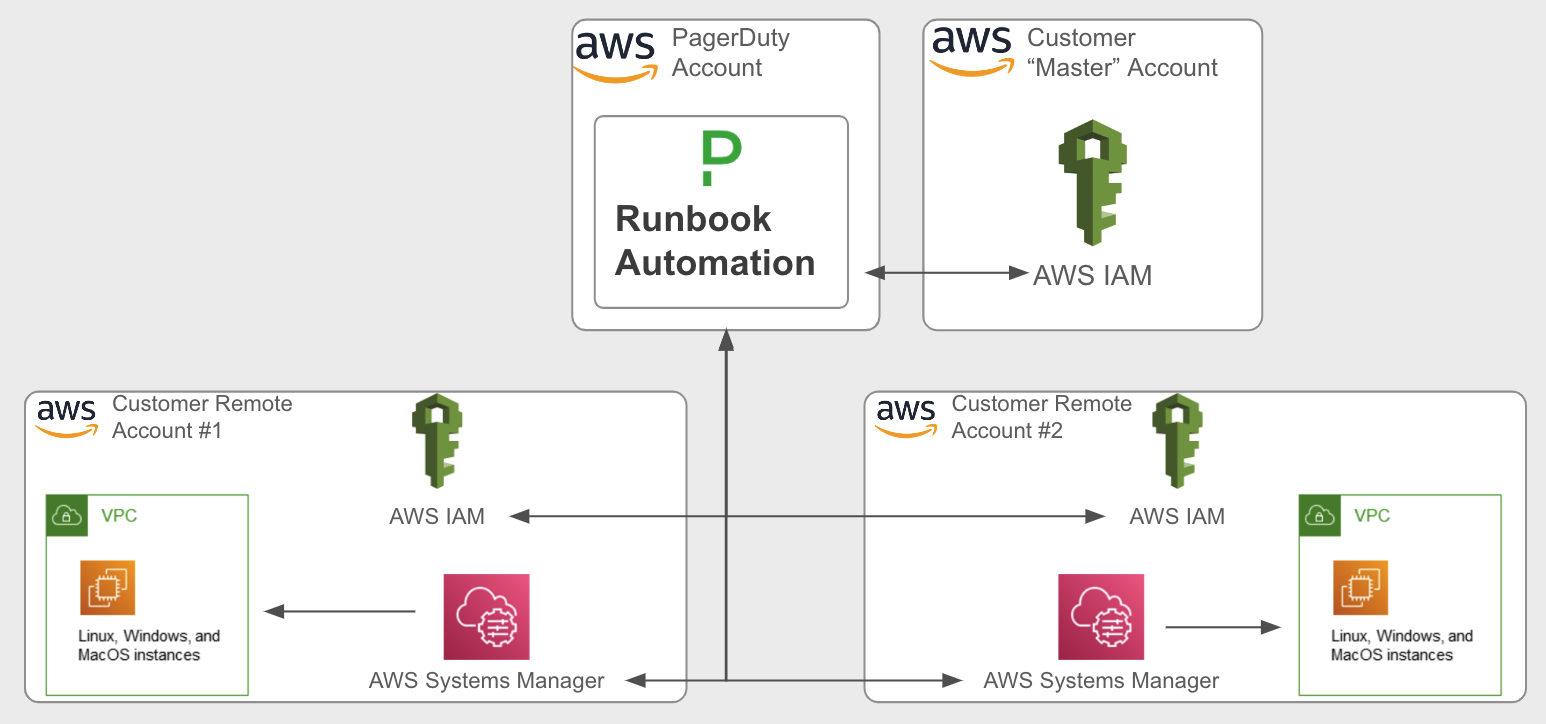
- Runbook Automation integrates with "Master" Account using direct integration.
- IAM Role in Master account has Trust Relationship with IAM ARNs in remote accounts.
- Runbook Automation uses Assume Role function to adopt permissions for remote accounts.
- Automation is dispatched to EC2's through SSM using remote account IAM role.
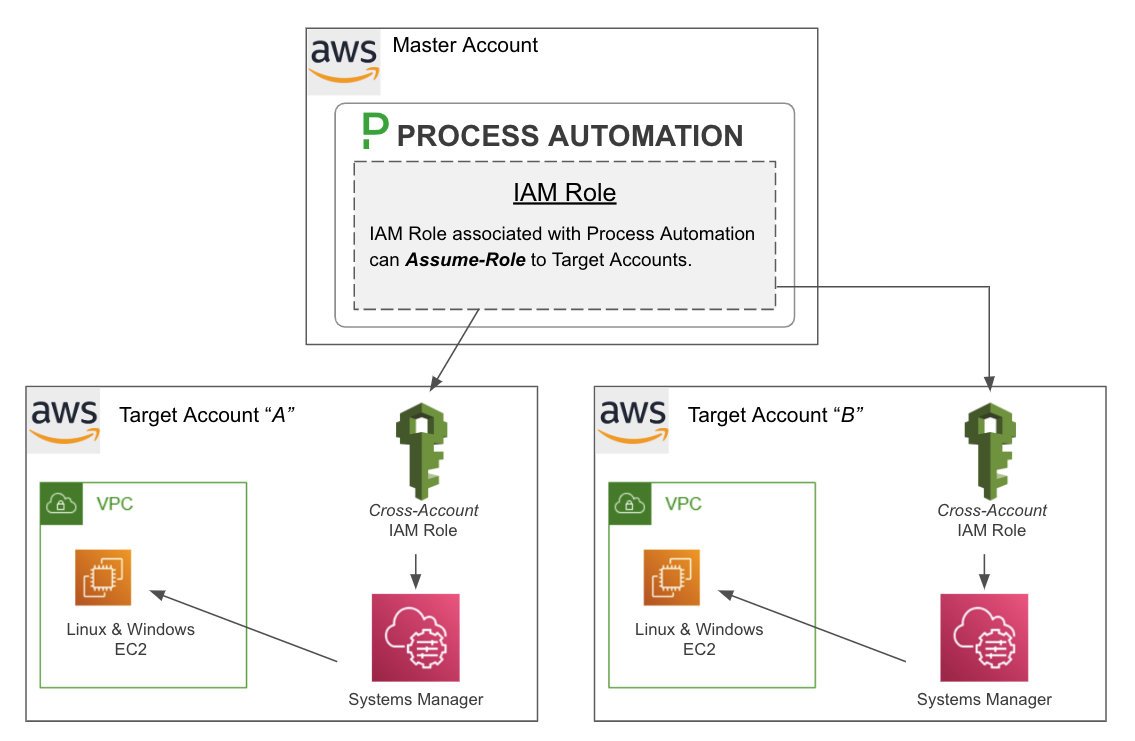
- Runbook Automation is hosted in "Master" account - on EC2, EKS or ECS.
- Through AWS integration, Runbook Automation inherits entitlements from IAM Role associated with EC2, EKS or ECS.
- IAM role from Master account has Trust Relationship with IAM role in remote accounts.
- Automation is dispatched to EC2's through SSM using remote account IAM role.
Here is the overview of the steps for this setup:
- Cross-Account Orchestration with AWS Systems Manager
Configure IAM Roles in Remote Accounts
IAM Role for Remote EC2s
In the remote AWS account, follow the steps to add EC2’s to the SSM managed inventory. If your EC2 instances have already been added to the managed inventory, then skip to Step 4 to test Run Command.
- Ensure the SSM Agent is running on remote EC2 instances. This can be done following this AWS documentation.
- Associate an IAM role with the remote EC2 instances that allows for the SSM agent to retrieve tasks from the SSM service.
- AWS provides a prebuilt policy: AmazonSSMManagedInstanceCore that provides the necessary permissions for this operation.
- Add the instances to the SSM inventory. This can be done using the Quick Setup Host Management.
- You can test that you have configured Systems Manager correctly by manually using the Run Command feature from AWS:
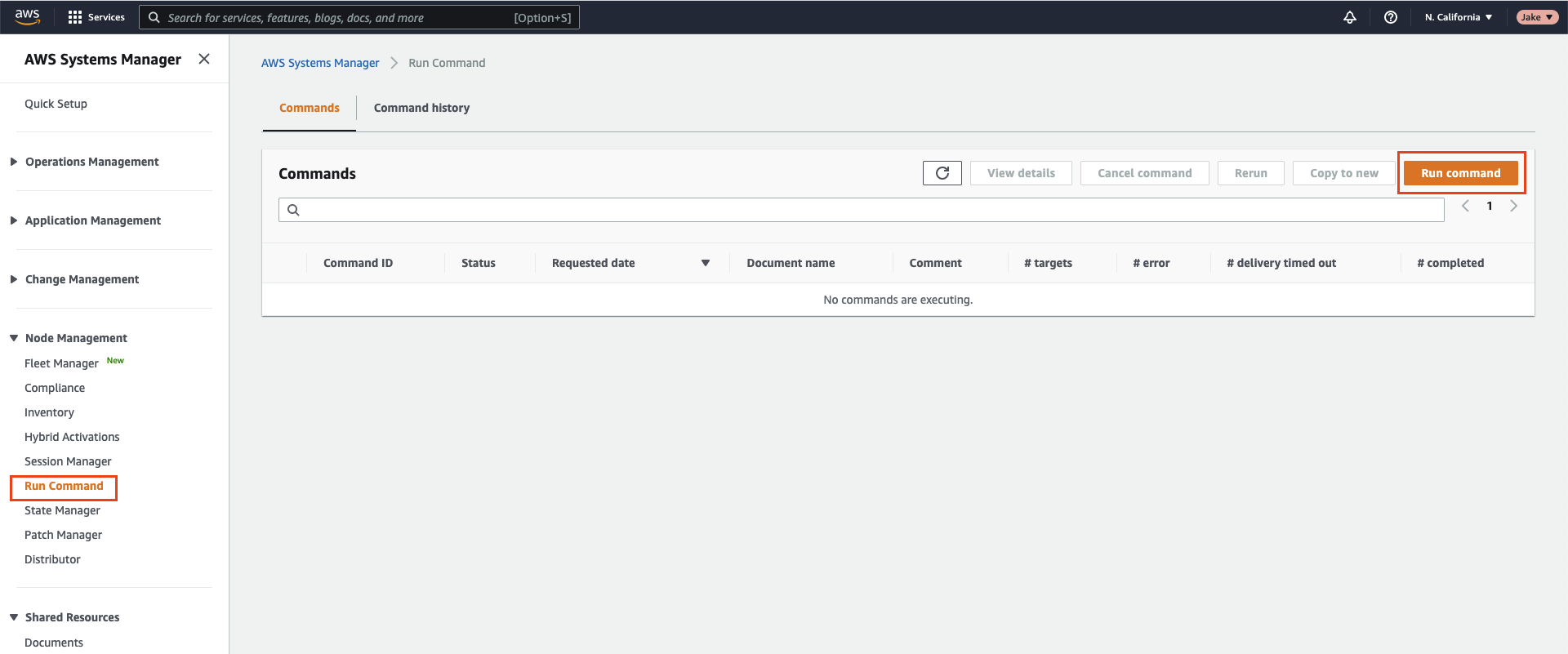
- Use the
AWS-RunShellScriptorAWS-RunPowerShellScript(for Windows) to test that SSM has been set up properly for the remote EC2 nodes.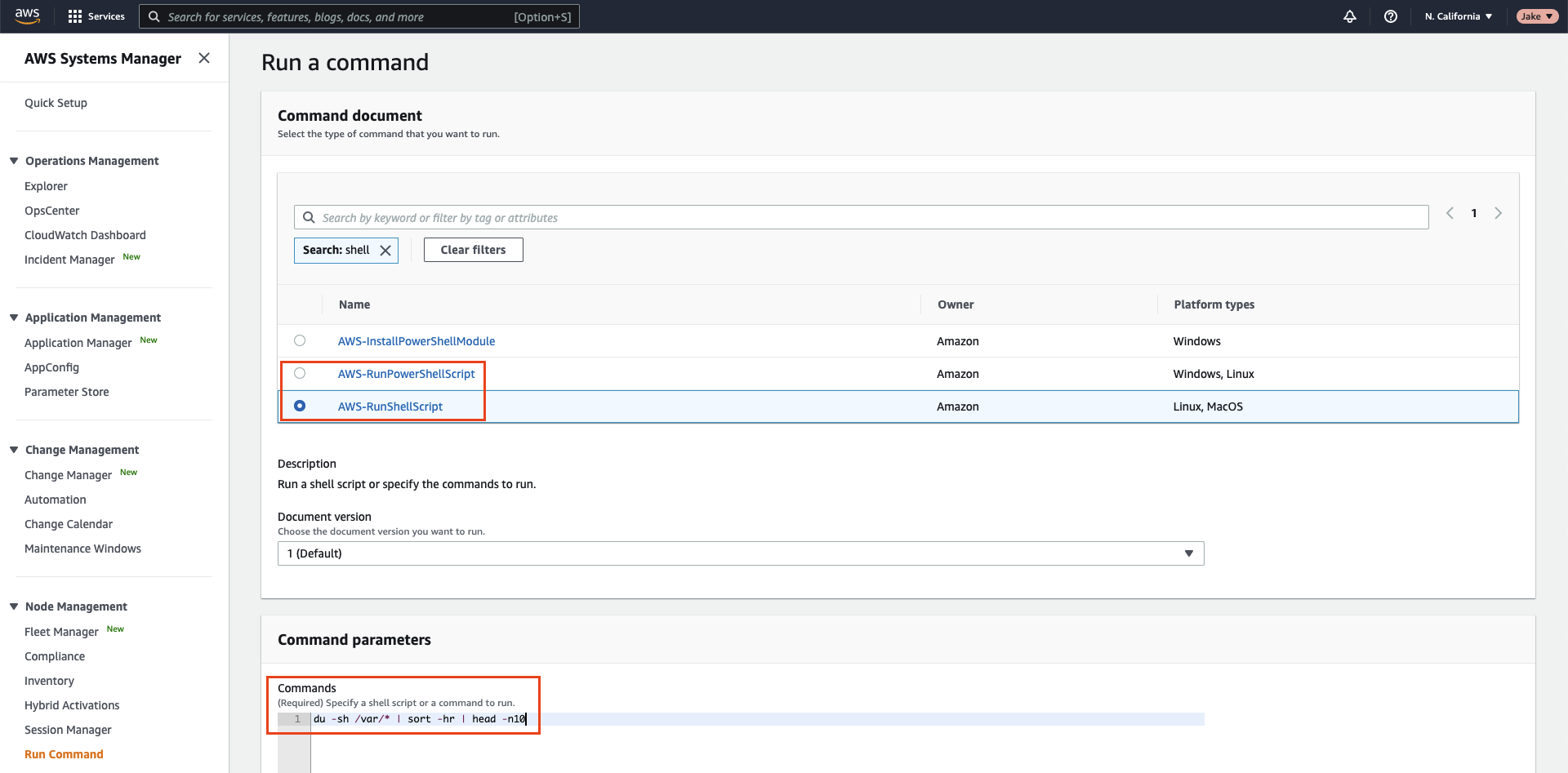
- Use the
Additional documentation on this setup can be found in the Setting up AWS Systems Manager for EC2 instances.
IAM Role for Cross Account Node Execution
Still within the Remote Account, Create an IAM policy (that will be added to the IAM Role later) that has permissions to execute commands on the EC2’s in this account using SSM. The primary permissions required here are:
ssm:SendCommandssm:ListCommandsssm:ListCommandInvocationsssm:GetCommandInvocation
And the policy must allow for the AWS-RunShellScript and AWS-RunPowerShellScript. Below is an example policy document with the minimum required permissions.
Heads Up!
Be sure to replace <<REMOTE AWS ACCOUNT ID>> with the AWS account ID of the remote account:
"Version": "2012-10-17",
"Statement": [
{
"Sid": "VisualEditor0",
"Effect": "Allow",
"Action": "ssm:SendCommand",
"Resource": [
"arn:aws:s3:::*",
"arn:aws:ssm:*::document/AWS-RunShellScript",
"arn:aws:ssm:*::document/AWS-RunPowerShellScript",
"arn:aws:ec2:*:<<REMOTE AWS ACCOUNT ID>>:instance/*"
]
},
{
"Sid": "VisualEditor1",
"Effect": "Allow",
"Action": [
"ssm:ListCommands",
"ssm:ListCommandInvocations",
"ssm:GetCommandInvocation"
],
"Resource": "*"
}
]
}
Tip! Instance Discovery Permissions
In order for Runbook Automation to also be used to discover the EC2 nodes in the remote account, it needs the permissions to list the EC2s. If this same IAM Role will be used for instance-discovery, then be sure to add the following policy to the above IAM Role as well:
{
"Effect": "Allow",
"Action": "ec2:Describe*",
"Resource": "*"
}
The AmazonEC2ReadOnlyAccess predefined policy can be used for this purpose, or a custom policy can be defined.
File Copier & Script Executor Permissions
The SSM policy outlined in the earlier section enables executing commands on the remote instances. Use the following steps to set up the ability to execute scripts on, or transfer files to (or between) EC2’s:
Add the following permission to the IAM Policy above: arn:aws:ssm:*::document/AWS-RunRemoteScript.
- Create an S3 bucket that has a bucket policy that allows for objects to be uploaded to it by the IAM policy associated with Runbook Automation.
- Include a permission statement in this policy that allows for the remote EC2 instances to retrieve objects from the bucket.
- Here is an example S3 Bucket Policy:
Heads Up!
Be sure to replace
<< content >>with your AWS Account ID's and ARN's.{ "Version": "2012-10-17", "Statement": [ { "Effect": "Allow", "Principal": { "AWS": "arn:aws:iam::<<remote EC2 nodes AWS account ID>>:role/<<ARN associated with remote EC2s>>" }, "Action": "s3:GetObject", "Resource": "arn:aws:s3:::<<name of S3 bucket>>/*" }, { "Effect": "Allow", "Principal": { "AWS": "arn:aws:iam::<<remote EC2 nodes AWS account ID>>:role/<<ARN associated with remote EC2s>>" }, "Action": "s3:ListBucket", "Resource": "arn:aws:s3:::<<name of S3 bucket>>" }, { "Effect": "Allow", "Principal": { "AWS": "arn:aws:iam::<<Runbook Automation AWS account ID>>:role/<<ARN associated with Runbook Automation>>" }, "Action": [ "s3:PutObject", "s3:DeleteObject" ], "Resource": "arn:aws:s3:::<<name of S3 bucket>>/*" } ] }
Tip #1 Multiple ARNs to Access S3
Multiple ARNs can be added to the Principal by using a list:
"Principal":
{
"AWS":["arn:aws:iam::<AccountBId>:role/<AccountBRole>", "arn:aws:iam::<AccountCId>:role/<AccountCRole>"]
}
Tip #2 Use AWS Organizations ID
Instead of listing all the ARNs for all the account roles, you can use the AWS Organization ID as a condition in your bucket policy.
condition {
test = "StringEquals"
variable = "aws:PrincipalOrgID"
values = [data.aws_organizations_organization.org.id]
}
Then, in the remote AWS account, modify the IAM Role associated with the EC2s (earlier referenced as AmazonSSMManagedInstanceCore) and add the following permissions
{
"Effect": "Allow",
"Action": [
"s3:GetObject",
"s3:ListBucket"
],
"Resource": "arn:aws:s3:::<<name of S3 bucket>>/*"
}
Be sure to change <<name of S3 bucket>> to the name of your S3 Bucket.
Tip!
You can test that the S3 permissions have been set up correctly by executing a simple script on the remote EC2s through the Systems Manager interface. Follow the instructions outlined in this AWS documentation to set up and run the test.
Add Trust Policy
In order for Process or Runbook Automation to assume the role with the SSM permissions, a Trust Policy must be added to the cross-account role in the remote account. First, navigate to the master account and copy the ARN of the IAM Role associated with Runbook Automation.
Master Account Reference
For Runbook Automation (Cloud), the master account is the AWS Account that is integrated through the Project or System using the AWS PluginGroup.
For Runbook Automation Self=Hosted, the master account is the AWS Account where Runbook Automation is hosted - either on EC2 or on ECS.
Navigate back to the remote AWS account where the cross-account role can be modified. Click on Trust Relationships then click on Edit Trust Policy. Use the following Trust Policy:
{
"Version": "2012-10-17",
"Statement": [
{
"Effect": "Allow",
"Principal": {
"AWS": [
"<<ARN associated with Runbook Automation>>"
]
},
"Action": "sts:AssumeRole",
"Condition": {}
}
]
}
Click on Update Policy to save the changes. Copy the ARN of this IAM Role (in the Remote account).
Update IAM Role in Master Account
Navigate back to the master account.
Find the IAM Role that is associated with Runbook Automation, and navigate to modify this IAM role in the IAM Console. For Runbook Automation Self-Hosted, see these instructions for EC2, or these instructions for ECS.
Now add the following policy to this IAM Role and paste in the ARN of the cross-account IAM Role copied from the remote account from the prior section:
{
"Version": "2012-10-17",
"Statement": [
{
"Sid": "VisualEditor0",
"Effect": "Allow",
"Action": [
"sts:AssumeRole"
],
"Resource": "<<ARN of the cross-account role created in the Remote Account"
}
]
}
IAM Role for ECS
If running Runbook Automation on ECS, then this IAM Policy needs to be attached to the Task Role, not the Task Execution Role.
Configure Node Executor in Runbook Automation
AWS Authentication
Follow the instructions outlined in the AWS Plugins Overview for Runbook Automation to authenticate with AWS.
Node Discovery
In order to target the remote EC2 instances, they need to be populated into Runbook Automation's node inventory. It is recommended to use the EC2 Node Source.
Place the ARN of the cross-account role into the Assume Role field.
When not using the EC2 Node Source
If the EC2 Node Source is not used for node discovery, then be sure that the following node-attributes are added to the nodes:
instanceId- This is the EC2 instance-id from AWS.region- This is the AWS region where the EC2 resides.osFamily- This is the os Family you need to specify if is a Windows node.
Enable SSM Node Executor & File Copier
Option 1: Individual Nodes and Node Sources Setting
The SSM Node Executor and File Copier can be configured on a per Node Source basis. This is the recommended approach when you have multiple remote accounts.
- For the EC2 Node Source, this can be done using the Mapping Params field. Add the following, separated by semicolons:
ssm-assume-role.default=truessm-assume-role-arn.default=<<ARN of the cross-account role created in the Remote Account>>node-executor.default=awsssmexecutor- Only required if SSM Node Executor is not the Default Node Executor for the project.file-copier.default=aws-ssm-copier- Only required if SSM Node Executor is not the Default Node Executor for the project.ssm-copier-bucket.default=<<S3 bucket name>>
If the same S3 bucket will be used across multiple Node Sources (thereby serving multiple AWS Accounts), and the Default File Copier is not set to use SSM, then this can instead be added as a Project level property: project.ssm-copier-bucket=<<S3 bucket name>>.
Option 2: Project Wide Configuration
The SSM Node Executor can be set as the Default Node Executor - thereby making it the standard node executor for the whole project:
- Navigate to Project Settings -> Edit Configuration -> Default Node Executor.
- Select the dropdown on the left and select AWS / SSM / Node Executor:
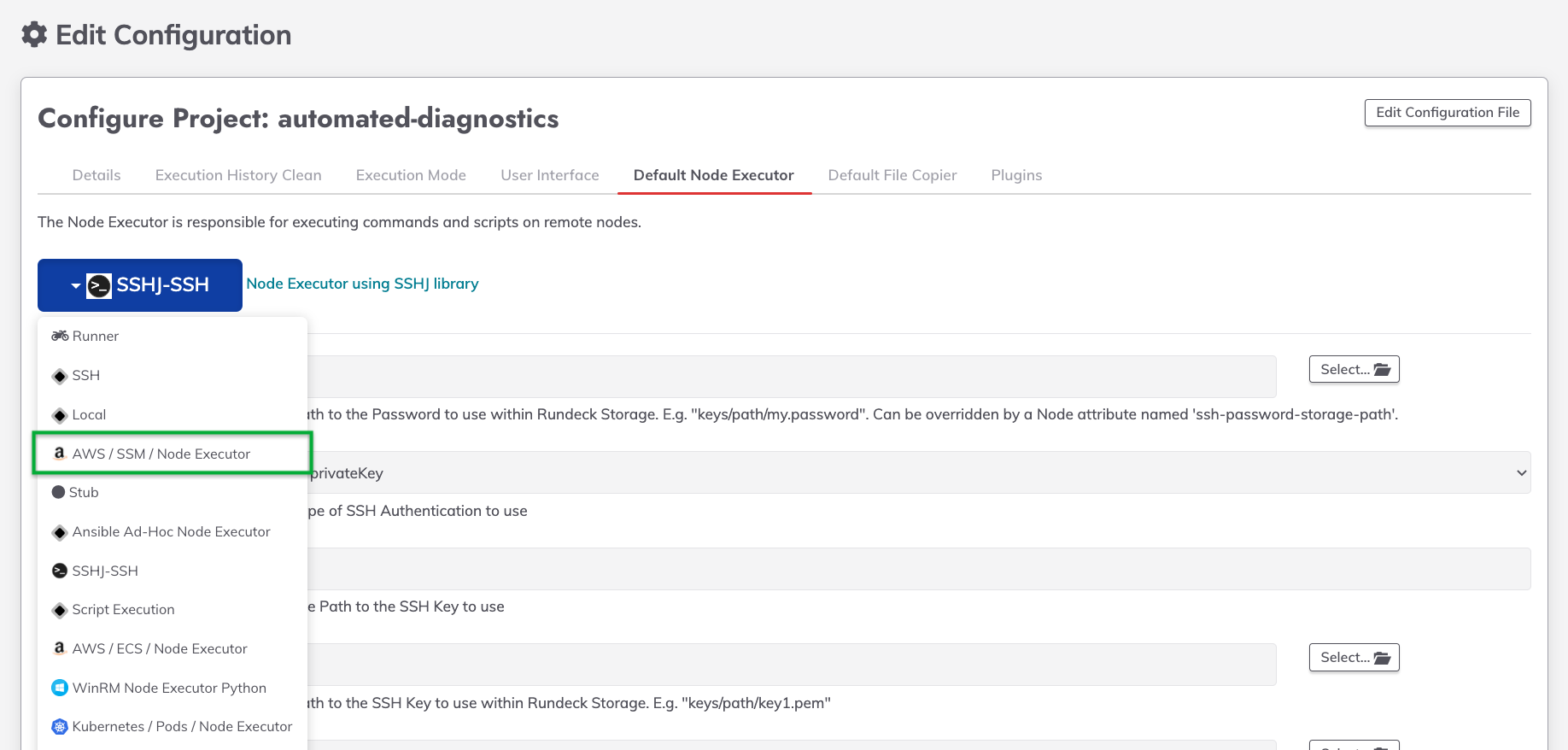
- If Runbook Automation is authenticated with AWS through an associated IAM Role, then all the fields can be left as their defaults.
- Click the check-box for Assume Role.
- Type in the ARN of the IAM role in the remote AWS account.
- If you have more than one remote account, you can leave this blank.
- See below for using CloudWatch Logs for larger log-output.
- Optionally modify the Log Filter Delay property to be the number of seconds to wait before retrieving logs.
Extended Execution Time
SSM executions support extended timeout configurations:
- With Assume Role: up to 12 hours (43200 seconds)
- Without Assume Role: up to 48 hours (172800 seconds)
- Inline Scripts: maximum 8 hours (28800 seconds)
See the Execution Timeout Configuration section for complete details and configuration methods.
The SSM File Copier can also be set as the Default File Copier for the whole project:
- Navigate to Project Settings -> Edit Configuration -> Default File Copier.
- Select the dropdown on the left and select AWS / SSM / File Copier.
- Place the name of the S3 bucket into the Bucket Name field.
- If Runbook Automation is authenticated with AWS through an associated IAM Role, then the Access Key ID and Secret Key fields can be left blank.
When not using the EC2 Resource Model
Node Attributes can be added when defining a resource-model source manually or by using the Attribute Match node enhancer. Use the same node-attributes listed above without default. For example, ssm-assume-role=true.
Using CloudWatch Logs
The example policies in the prior sections enable Runbook Automation to retrieve logs directly from SSM.
However, these logs are truncated to 48,000 characters. To view logs that are longer than this limit, CloudWatch logs are used.
In order to use CloudWatch, specify the CloudWatch Log Group in the Node Executor (therefore to be used across multiple Node Sources) or as a property added to the Mapping Params cloudwatch-log-group.default=<<CloudWatch Log Group Name>>.
Then, use the policies below for the IAM Roles. Again, both of these are in the remote account.
Full policy for Cross-Account-Role:
{
"Version": "2012-10-17",
"Statement": [
{
"Sid": "VisualEditor0",
"Effect": "Allow",
"Action": "ssm:SendCommand",
"Resource": [
"arn:aws:s3:::*",
"arn:aws:ssm:*::document/AWS-RunShellScript",
"arn:aws:ssm:*::document/AWS-RunPowerShellScript",
"arn:aws:ec2:*:<<REMOTE AWS ACCOUNT ID>>:instance/*"
]
},
{
"Sid": "VisualEditor1",
"Effect": "Allow",
"Action": [
"ssm:ListCommands",
"ssm:ListCommandInvocations",
"ssm:GetCommandInvocation",
"logs:GetLogEvents"
],
"Resource": "*"
}
]
}
Policy to add to remote nodes (EC2’s):
{
"Version": "2012-10-17",
"Statement": [
{
"Effect": "Allow",
"Action": "logs:DescribeLogGroups",
"Resource": "*"
},
{
"Effect": "Allow",
"Action": [
"logs:CreateLogGroup",
"logs:CreateLogStream",
"logs:DescribeLogStreams",
"logs:PutLogEvents"
],
"Resource": "*"
}
]
}
